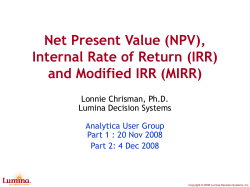
Document 180736
Thailand Petroleum Concession Marginal Field in Thailand Concession System = Exclusive rights and obligations for petroleum operation under given areas for a specific given time period • Concessionaires shall invest and absorb all incurred risks • Concessionaire shall hold the right to store, transport and sell petroleum. • Benefits to the state in form of petroleum royalties and taxes March 13, 2005 Boonbandan Yuvanasiri Aree Rittipat Thailand Fiscal Regimes Thailand III Concession System • Royalty & Tax Regimes • 2 Groups Thailand I Regime: 19711971-1981 Thailand II Regime: 19811981-1989 (outdated) Thailand III Regime: PostPost-1989 Government Take: • Royalty Sliding scale rates from 55-15% on gross revenue, based on production • Petroleum Income Tax 50% • Special Remuneration Benefit (SRB) Progressive rate from 00-75% on “Windfall Profit” Profit” PSC System • MalaysiaMalaysia-Thailand Joint Development Area (MT(MT-JDA) MTJA PSC 1 Why Thai III ? Amended in 1982 Objective: • Attracting marginal field by applying sliding scale royalty. • Ensuring of government take for high potential field by applying SRB (Windfall Profit) Thai III for Marginal Field Oil Field Area Field Onshore Offshore Reserve (MMBBL) Production Rate/Day (BBL/D) Royalty % PTTEP I 2 180 5 SINO 37 428 5 Wichain Buri 1.3 94 5 Jasmine 22 Project is in progress Gas Field Area Field Reserve (Bcf) Production Rate/Day Offshore Bussabong 158 Bcf Pending What is “Marginal Field” Field” for Thailand? A “marginal field” field” is a field which economics do not meet acceptable rates of return. A “marginal field” field” can be defined as an agreed (between government and concessionaire) threshold rate of return (IRR), under certain agreed assumptions of CAPEX and OPEX of development and production, price scenario of oil and gas. Petroleum Type Oil or Gas Price h ig or H Low Resources Size Inf ras t Dis ructu r ta n ce e n or e tio ffsh ca L o or O ore sh On Factors s Statu ration pe ng O Existi r O ct Proje New 2 Case Study: Bussabong Offshore, Gulf of Thailand Gas and Condensate Resources Size: 158 Bcf of gas, 500 Mbbl of condensate Price: $2.07/Mcf, $24/Bbl Sunk Cost : Tangible 0.159 MMUS$, Intangible 6.111 MMUS$ Additional cost for stand alone development : 80 MMUS$ (60 MMUS$ CPP + 20 MMUS$ dedicated export pipeline) Production life 7 years Bongkot, PTTEP Bussabong, Pearl Oil Incentive Study for Stand Alone Development Economic Analysis Scenarios Stand Alone Stand Alone (Zero Royalty) 10.5 12.4 59 70 NPV @ 10% (MMUS$) 2 9 NPV @ 12% (MMUS$) -5 1 NPV @ 15% (MMUS$) -13 -7 IRR % NPV @ 0% (MMUS$) Royalty relief • Impact on NPV but it is not much attractive for investor. Relief SRB term : Increase Geological Constant (K) : Introduce Special Reduction • No impact on NPV because project already does not have to pay SRB. Tax relief • No impact for first 5 years of production because tax will be paid after the fifth years of production and in decline period of the field. 3 Economic Analysis Scenarios IRR % Incentives for Synergy Development Stand Alone Stand Alone (Zero Royalty) Satellite to Bongkot 10.5 12.4 18.9 59 70 67 NPV @ 10% (MMUS$) 2 9 20 NPV @ 12% (MMUS$) -5 1 15 NPV @ 15% (MMUS$) -13 -7 7 NPV @ 0% (MMUS$) Project Development Approaches Initiating a synergy facilities approach by encouraging a commercial deal between operators. Initiating PITA relief program for owner of facilities. Process is in progress. Satellite to neighborhood field • Impact to NPV which it shows to be the best option to develop the field. More Approaches to come! : To boost up and encourage E&P business in Thailand, we plan to attack our challenge in marginally field development; 1. Short Term for existing concessionaire • Royalty Reduction Case by case basis • SRB adjustment 2. Long Term for new comer (Amending the Law) • Introducing a new regime. • Eliminating “Ring fencing” fencing” for PITA. 4 Thank you 5
© Copyright 2025



















